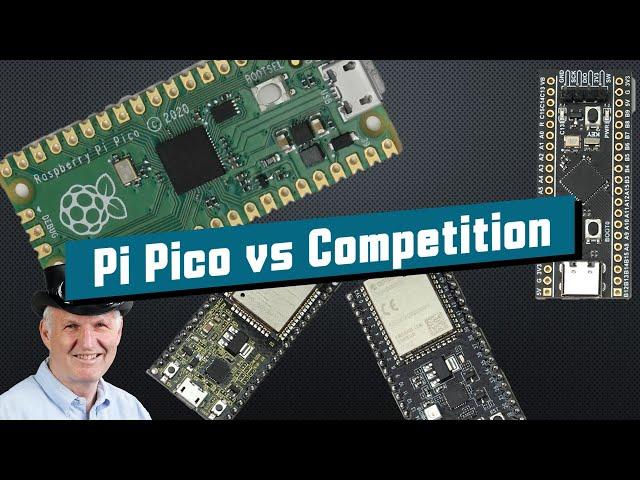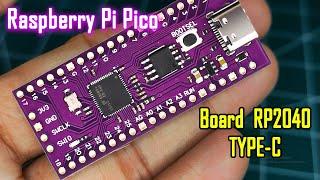
#370 Raspberry Pi Pico vs ESP32 (-S2) and STM32 Blackpill
Комментарии:

You forgot about the interpolators which support clamping ranges and blending modes, the intercore FIFOs, single cycle GPIO access, 8 cycle hardware dividers, and you just brushed over the PIO, which is extremely capable. I've seen people add support for CAN bus using the PIO, along with USB, manchester encoding, differential manchester, ps/2 keyboard interfacing, bitwise and simple alu operations, and basically any encoding that you can describe by bitbanging.
Its a finicky little thing but you can get it to do a whole lot, and the documentation is very solid. I don't think your assessment was completely fair, but from the perspective of your average hobbyist who isn't reading through the 640 page reference manual, I would agree with most of your points. Its just not the full story.

Hello. Cool. I made a project like PicoBasic for those who miss BASIC from the 1980s (me). I developed a board with the RP2040 and another for the inputs/outputs with USB, AUDIO, Relays, SDcard, VGA. I adapted the original code (which is not mine) to include the ABNT standard keyboard. The manufacturing files, electrical diagram and videos are on my channel.
Ответить
Rp is mi6 chip
Ответить
Well, the main point of the PIO is that rarely used protocols can fairly easily be added without taking the cpu time of the main core.
In one project by myself I needed I2S in slave mode which was a great case for the PIO.

it is easy to run out of GPIOs on Pi Pico !!! I hate that.
I am waiting for them to make Cortex-M7 board !

A great video🔥. But using SDK is kinda hard for me to grasp😓. If you have a link to any resources I may use please share and I using windows don't know if its ok.
Ответить
about the missing I2C and canbus
the PIO is basically capable of letting you create whatever type of interface yout want (it's been used to create VGA output, for example)

Ok so Arduino is for the most part targeted at hobbiest as is the Raspberry Pi( though due to lack of control over price gauging the pico is the only pi that is affordable). While the ESP and ST are for comercial usage.. hence the arduino ide while it works you wont get the same features as a comercial ide( i.e ST CUBE IDE or Arm dev studio) but for students and hobby its good enough. The Atmega mcus arent really built for industrial applications but are cheap. Way cheaper then the Nucelo64( which is really cool but is pricy as it costs about €100 per two units though it cant be fairly compared with the hobby mcus as these are indeed built for serious industrial applications( you program it and it will run for at least 20 years )
Ответить
i wonder if it is worth it to re-watch this old video, because today i hear about these ESP32-PICO-V3 and ESP32-PICO-d4 chips, if they are relevant / worthwhile alternatives to rp2040 chip or the complete wroom esp32 module (including wifi antennae etc)
Ответить
I know I'm linguistically biased but I can't stand the "SRAM" term because pronounced "sram" and not "s-ram" is a word in my language. It means "I shit" or "I'm shitting".
Ответить
2023 and the cheapest pico I found was $7
Ответить
Does someone has info about the co-processor is a riscv? If it's indeed an RV32I with C and M extension it must have more than 9 instructions, or can't use the rv32I name. I wrote an emulator for the RV32i and with M extension not so long ago and the base instruction set alone has about 40-50 instructions or so.
Ответить
I'm so pleased with this chip! The PIOs (8 of them) can be used to recreate ANY protocol you want, or maybe invent a protocol too 😉
I have created an improved version of WS2812 drivers, making them fully autonomous with DMA. The INMP441 has tricky I2S data format, but it was seamless (without CPU overhead) with the PIO. It is just magic!

My only reason for using the PICO is to learn python, it's a shame seeing all the cool shields for the arduino - but I am persevering due to the supported language
Ответить
One thing to note. You should NEVER, but NEVER NEVER NEVER try to compare performance using only the specs of the chips.
Architectures are different, clock behavior, Instructions Per Cycle, Power Efficiency, Thermal tolerances.
All of those contribute to the performance, and performance should only be compared with real world tasks.
Every chip will be better on some tasks compared to others. But you should never compare them using the specs written on paper.

Thank you for the great video. Looks like a typo but I found some projects using the pi pico using I2C for example for an organ.
Ответить
I thought that ARM did a deal with RPF for the initial PI. As the RPF was original charity orientated I think the ARM license was "free"[tm]. ARM probably still make returns on the manufacturing licenses per chip, but I don't think RPF pay the arch licensing fees. I could be wrong. ARM don't make CPUs. They don't make MCUs either. They provide a licensed core architecture and consult and partner with chip designers for licensing fees. The chip designer (STM, RPF etc.) make and sell the chip and (I believe) pay per unit royalties to ARM.
Ответить
Hey, nice video, thanks! So, more than a year and a half after this one, how the things are going with the Pico? Is it worth it? Has it proved as useful as advertised? I got one today and I intend to tinker with it for a while. I got it for a little above 5 euro (less then 5.5 though) from an official store. Also got an Ethernet hat for about 8 euro (from the same store) to see how it is going to perform as a network device. Also, there already is a library for CAN bus communication via the PIO. Actually I want to try to use the PIO to implement another protocol, popular in the model railroading (LocoNet). Someone may have done that already, but I can't find any info about it (only some ideas and intentions like mine).
Ответить
It sounds like speech synthesizer voice, however content is of Novice good 👌
Ответить
Time to update the video for the Pico W
Ответить
Thanks Andreas!
Ответить
I realize this video is quite old now. I obtained the original Pico board this week and attempted to make it work with PlatformIO on Linux. There is some support, but it does not seem to work 100% yet. I will now go and see if you have re-visited Pico's on newer videos :) Thanks for a great channel!
Ответить
Pi PICO now has a version with WiFi so can compete with the ESP boards on this too.
Ответить
Thanks for the useful overview. One area I think you should take another look at is the PIO. Having these powerful co-processors will be immensely useful for their ability to (with precise timing and speed not possible using traditional bit-banging) emulate most any protocol, including ones not invented yet. I've seen implementations of VGA, DVI, CANbus and others. IMO it's one of the most unique features of this chip.
Ответить
- The PICO W DOES HAVE WIFI AND BT !
- The RP2040 can work at 240MHz !
- RAM size and Flash size diferences are of no consequence! ! No one will need more than 4 Mbytes of flash!
- PICO doesn't need EEPROM as programs can write to flash directly if they need to save data, there is even a file system for that. And besides... ESP having only 512 bytes of EEPROM is ridiculous and totalu useless.
- PICO exposes 27 GPIO ... not 26!
- ONLY 25 GPIO ARE AVAIBLE ON THE ESP32 !!!!!!!!!!!!!!!!! The ESP32 uses 7 IOs for the Flash Memory !!!
- The PICO has PIO !! That is a HUGE ADVANTAGE !! Of course, for kids and curious people who don't really know how to program and just cut and paste bits of "arduino" code, they don't even know what PIOs are...
- The PICO does not need a programmer! Its has mass storage emulation, just copy the .elf file and its done! And if we are programming in Python we can run the program instantly from the editor/IDE without having to flash
And most importantly, PICO has totally European technology and manufacturing... ESP is Chinese, not a cent more for these guys! ... PICO is 4 times less the price !

Bought a couple pico's last year and just looked at them this week. Have a washing machine that needed a timer so i programmed it to fill until a float switch closed and added times for wash, spin, refill and rinse. Added appropriate relays for the motor and fill solenoids and there ya go! Even put some LEDs on the panel to tell me what cycle it was in.
Ответить
Pico w for $6usd, be interesting to compare that to esp32
Ответить
Nice video! Congrats. 👏👏👏
Ответить
Because it's so cheap I just added a pi pico to my order last time I was buying electronic parts
Ответить
Nearly 18 months later but the Raspberry Pi Pico advantage is there now - given the supply chain issues with the ARM CPUs. The Foundation secured a flow of chips that is paying off for them.
Ответить
I can literally not pick out any reason to get the Pico over an ESP32. I'll be sticking with my go-to, the LOLIN S2 Mini
Ответить
Hope you enjoy your summer holiday 2022 with your wife and think about the Pico W and projects that might run with that in the autumn of this year.
Ответить
Those state machines are doing some amazing things these day like helping to emulate older machines with VGA output. I've even seen a full-fat BBC Micro (OK, it's only a 6502 but still) and some early generation console game emulators for the NES! And (as this is 18 months later give or take) I just took delivery of a new WIFI model! Woo hoo.
Ответить
...we all laugh Arduino... and sometimes we luv it too.
Ответить
Damn, this guy replies to every comment,
Ответить
I really like that I can plug USB directly and do not harsh with FTDI unit. However due to missing WIFI lot its not suitable for lot of projects
Ответить
Have you seen the WizFi360-EVB-Pico - a pin compatible Pico with WiFi and Bluetooth.
The Pi hut has just released them - interested to see what you think?

My only real complete with the pico is its pins arn't 5v tolerant vs most of the stm32 family. I think the PIO makes up for it, but I still like to play with older 5v components.
Ответить
Any thoughts on the ESP32-C3? It has only a single Risc-V core. However, it doesn't seem to have a USB 1.1 Host/Device or SWD/PlatformIO.
Also, instead of CAN, it has a Two-Wire Automotive Interface (TWAI)?
How bad is the12-bit ADCs on the ESP32s?

I bought one on launch because it was neat and $4, custom RPI silicon! Interesting piece of history at least. Maybe it's a misperception but the pi foundation still feels like an underdog.
Ответить
with official Arduino IDE we can't use second core on Pico...
Ответить
Hi, in the flash section you say : "264KB is big enought to arduino c programming, where we compile the code", what does it mean?
Ответить
The price comparison it not that good in my opinion. (Obviously stuff changed since the video...) I can get a Pico from a official raspi approved retailer for 4€, but if I get an esp for that price, 3/5 will fail (at least in my experience). So (at least right now) I have to pay 10€ for a esp to get some QC.
Ответить
hi, I would like to know the business cooperation conditions in your channel.
Ответить
Cool
Ответить
Interesting comparison. Small clarification, STM32F4 does have usb 2.0 host/device/otg capabilities. Not just 1.1 like the RP2040.
Ответить
Very informative but you sound like a robot. Byeeeee
Ответить
I think the real reason for designing their own chip is to slowly spread this up the range and maybe start their own RISC-V core in the future, that way they can break their dependence on ARM and reduce costs, while also having the rights to the GPU core, which has been a major stumbling block in Pi development in the past.
Ответить

























